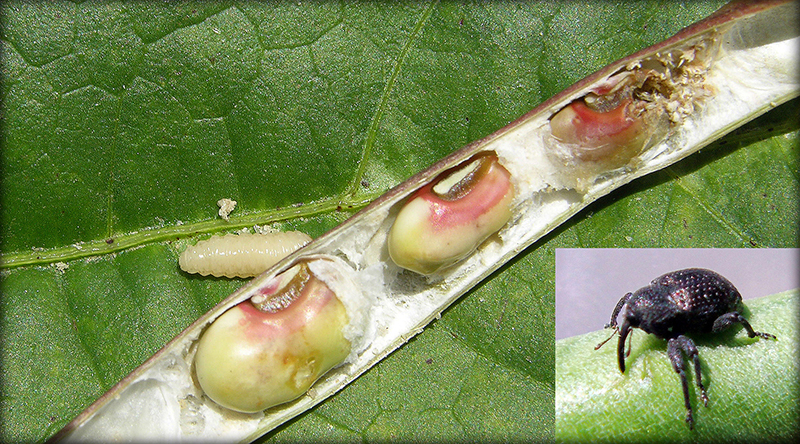Athens, Georgia, USA
February 9, 2018

Damage done on Southern pea by cowpea curculio
Once a top agricultural commodity in Georgia, the Southern pea’s presence in the state is now minimal. Growers are reluctant to plant the crop due to a tiny weevil, the cowpea curculio.
The cowpea curculio is a small, dark weevil that originated in Mexico. It feeds and lays eggs in the pods of Southern peas, making the peas unmarketable. The current management tactic involves spraying regularly with old and new insecticides, but the weevil has such high resistance that this technique has little impact.
“Cowpea is to Southern peas as the boll weevil is to cotton,” said University of Georgia entomologist David Riley. “With the boll weevil though, there wasn’t widespread resistance like there is with the cowpea curculio. Over time, curculios built up in Georgia, and now they won’t go away no matter what we spray. The insecticides are not working, so we have to find a way to stop them from reproducing.”
For the past seven years, Riley, a scientist with the UGA College of Agricultural and Environmental Sciences, has researched ways to manage cowpea curculios. His latest research could be the most fruitful.
He knew that cowpea curculios don’t like to live or reproduce on snap beans, but they may feed on the bean.
“Snap beans are a new-world plant that have been around weevils for a long time, so they’ve built up a resistance to them,” Riley said. “An inhibitor in the plant’s gene prevents the cowpea curculio from digesting (the plant).”
Riley consulted with T.J. Higgins, a leading plant gene scientist with the Commonwealth Scientific and Industrial Research Organisation in Australia, about his cowpea weevil studies. The weevil feeds on stored seeds, not fresh, green pods. Snap beans have a natural resistance to the weevil, so Higgins extracted that part of the bean’s DNA and injected it into the pea’s DNA. As a result, he found that the cowpea weevils stopped feeding on the peas.
If this DNA injection method stops the cowpea weevil from feeding on peas, Riley wondered if it could also stop the cowpea curculio from reproducing on cowpea plants.
“(Dr. Higgins) has had different seed companies interested in research regarding these peas,” he said. “We’re going to plant the seeds we receive from Australia and see if they stop the cowpea curculio from reproducing.”
Currently, cowpea curculio infestations are heavy in Southeastern states like Georgia, Alabama and South Carolina.
“Cowpea curculio is a new-world weevil from Mexico, and the Southern pea is from Africa,” Riley said. “When Southern pea and the cowpea curculio got together, it was a perfect match.”